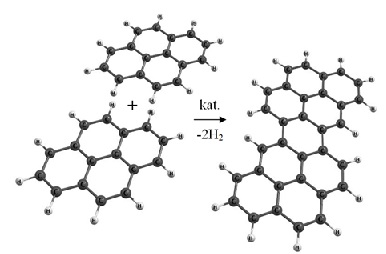NANOSYSTEMS: PHYSICS, CHEMISTRY, MATHEMATICS, 2018, 9 (1), P. 106–109
Catalytic pyrene and pyrene butyric acid condensation as a means of producing graphene
O. A. Shinkarenko – Department of Nano- and Biomedical Technologies, Saratov State University, Saratov; Education and Research Institute of Nanostructures and Biosystems, Saratov State University, Saratov, Russia; oksana.sh63@mail.ru
M.V. Pozharov – Institute of Chemistry, Saratov State University, Saratov, Russia; dm89@yandex.ru
A. S. Kolesnikova – Education and Research Institute of Nanostructures and Biosystems, Saratov State University, Saratov, Russia; kolesnikova.88@mail.ru
A. S. Chumakov – Department of Nano- and Biomedical Technologies, Saratov State University, Saratov; Education and Research Institute of Nanostructures and Biosystems, Saratov State University, Saratov, Russia; lehahares@rambler.ru
A. J. K. Al-Alwani – Babylon University, Babylon, Iraq; ammarhamlet2013@yahoo.com
O.Yu. Tsevtkova – Education and Research Institute of Nanostructures and Biosystems, Saratov State University, Saratov, Russia; olgatsvetkova77@gmail.com
E. G. Glukhovskoy – Department of Nano- and Biomedical Technologies, Saratov State University, Saratov, Russia; glukhovskoy@gmail.com
In the present study, we have conducted molecular modeling of a potential method of graphene sheet formation. As the nano-sized blocks from which graphene can be synthesized, pyrene and pyrene butyric acid are chosen. The potential of several compounds (namely, Pt, Pd, Ni, AlCl3 and PdCl4) as catalysts for hydrocarbon condensation has been estimated by semiempirical calculations. The heat of formation in the series Pt, Pd, Ni, PdCl4, AlCl3 for pyrene is reduced to a minimum and reaches a value of 99 kJ/mol, and for pyrene butyric acid in the series Pt, Ni, Pd, PdCl4, AlCl3 decreases to 295 kJ/mol. According to the results of calculations, Pt and Ni can be the most effective catalysts for this reaction. As a substrate (or 2D nanoscale), we propose to use a surface of water or a monolayer of surfactants on water (this method is realized by the Langmuir–Blodgett method) having a 2D crystal structure whose state can be controlled by external conditions.
Keywords: graphene, catalytic condensation, Langmuir–Blodgett method, polycyclic aromatic hydrocarbons, semiempirical computations, 2D nanotemplate.
PACS 68.65.Pq, 68.47.Pe
DOI 10.17586/2220-8054-2018-9-1-106-109
